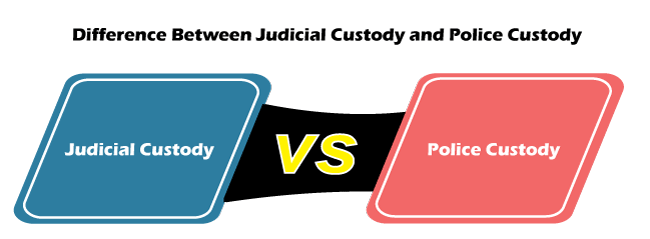Difference between Judicial Custody and Police CustodyWe might have heard the term 'custody' many times. Well, custody refers to the guardianship of someone or something. But this is just one meaning of the term. In civil services, custody refers to the imprisonment of a particular person who has committed a crime. Many of us are often curious about the term that what does it mean, what happens in custody, or what are the different forms of custody, etc. There are two kinds of custody, i.e., judicial custody and police custody. Both seem to be the same but are different. So, before discussing any further, let us see the differences between the two.
These differences show how both the terms are unidentical. Judicial custody and police custody are two different forms of preventive measures taken by the government to limit the crime in their respective states. So, let us discuss about them in detail. Judicial custody is defined as the custody wherein the accused is under the custody of a Magistrate. The person who has committed the crime is in jail under judicial custody. Well, it is important to note that the accused can either be sent to police custody or judicial custody depending upon the crime he/ she has committed. Initially, a person is taken into police custody, and then he/ she is presented before the Magistrate. The Magistrate decides either to keep him/ her in police custody or judicial custody. 
On the other hand, Police custody is defined as the custody wherein the accused is in the physical custody of the police. The suspect under police custody remains in the lockup. The time duration for which the accused remains in police custody is 24 hours. After 24 hours, the police have to grant bail to the accused if he/ she is not proven guilty. Within these 24 hours, the accused must be interrogated and produced in front of the Magistrate/ Judge if proven guilty. Let us see a few key points regarding the term custody.
These are some key points regarding the custody. Well, it is interesting to note that all the decisions regarding custody are taken according to section 167 of the criminal procedure. According to section 167, the accused can be held in police custody for 15 days upon the orders of the Magistrate. This duration can be further extended to 7 days. The Magistrate has the authority to send the accused in judicial custody or police custody. According to section 436A of the criminal procedure, if the accused under judicial custody has undergone half of the punishment, then he/ she can be granted bail as per the law. The judicial custody can be extended till 60-90 days depending upon the crime committed by the accused and the punishment given to him. In both judicial and police custody, it is prohibited to use physical violence against the accused. The police officers cannot hit the accused as that would be illegal, and a case can be filed against the officer for the same. There are four kinds of evidence that can prove a person guilty in police or judicial custody.
These four kinds of evidence help in determining whether to keep the accused under police custody or judicial custody. The key differences regarding judicial and police custody are given above. We are often confused between these two terms, but there is a sharp difference between them. There is a difference in how an accused is treated, the time-duration, the criminal procedures, etc. Thus, both judicial custody and police custody differ in many aspects.
Next TopicDifference between
|
 For Videos Join Our Youtube Channel: Join Now
For Videos Join Our Youtube Channel: Join Now
Feedback
- Send your Feedback to [email protected]
Help Others, Please Share










